Best way to improve balance
Do you feel as though your balance is poor? Perhaps you've tried some new exercise or activity which has revealed to you that your balance is not as good as you thought it was. Maybe you hold off from doing certain activities for fear of falling and hurting yourself.
I also used to struggle with balance. I remember playing a game on a kids playground where I had to copy what my friend was doing. He walked across a bar and I was meant to follow. Instead I was completely unable to get myself to move. It was like I was paralysed from the fear of falling because I knew my balance wasn't up to scratch.
Now, many years later. I can do many things that I couldn't do before. I can walk across a long slackline. I can walk between those drooping chain things they have at parks. I can walks down long metal handrails. Check out this video I made a few years back of practicing balance.
I went through a journey (a really fun one I might add) of discovering the best way to improve my balance. Once I embarked on my professional training in the Feldenkrais Method I started to experience vast improvements in my balance. I want you to know that no matter how unbalanced or uncoordinated you might feel right now, you can make big improvements to your balance too.
Through my journey I began to understand that balance is about what's happening in our brains. Much of the common advice you might read about balance misses this key understanding and it leaves a lot on the table in terms of potential improvement.
If you want to know the best way to improve your balance, it's worth first understanding how balance works. This will allow you to start practicing with activities that will make the biggest improvement.
Ready? Lets go!
Learn simple physics to understand balance
I figure the best place to start is with the fundamentals of how we actually balance.
I am a trained mechanical engineer. In my training we did lots of exercises in physics. This is ways of understanding how physical objects interact with gravity and other forces. Physics is one lens we can view balance through that provides useful information. So lets take a look.
Balance in a physics-sense works like this.
If you've got an object resting on the ground it has a centre of gravity. There's a bit to this concept, but for simplicity sake it's an imaginary point which we can consider the force of gravity to move through.
A cup of tea has a centre of gravity like this.
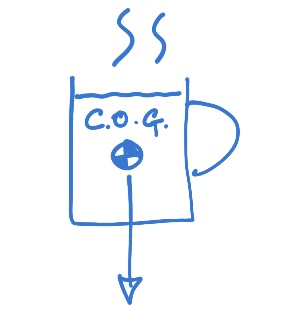
There's also something called a base of support. This is basically the widest extent at which the object is touching the ground.
The base of support for a cup of tea might look like this..
[baseofsupportcuppatea]
If our centre of gravity is within the bounds of our base of support the object is at rest.
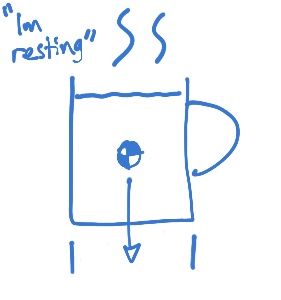
If it moves out of the bounds of the base of support the object will fall.
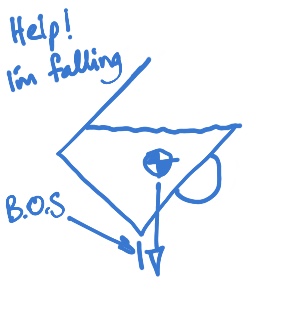
With objects that are low to the ground and with a wide base of support they are considered more stable. For example, your dining room table is highly stable. This means you could give it a hard push from the side and it wouldn't fall over.
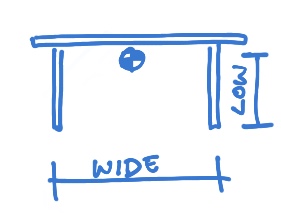
With objects that are tall and with a narrow base of support, they are considered unstable.
A tall lamp is more unstable. If you even give it a light bump from the side you may knock it over.
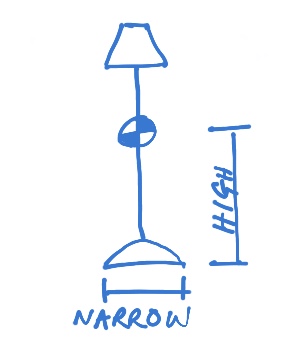
Us humans are more like a tall lamp than a table. We have a high centre of gravity and we have a narrow base of support. We are inherently unstable.
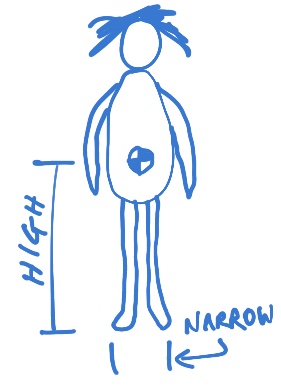
Understand the balance tradeoff
Now there's a tradeoff which is happening here which is important to understand. That is the tradeoff between stability and movement.
That table is stable, but because of that stability, it's difficult to move.
The tall lamp is unstable, so it at a higher risk of falling, but it has the advantage of being easy to move.
Now considering that we live in a 3-D world with gravity, 2 of our fundamental goals when it comes to being human are...
- Be able to move around the world.
- Keep our head at the top. ie: Don't fall over.
Ideally we'd like to maximise our abilities in these 2 areas. It's great to be able to move around easily and it's great to not fall over.
The problem is, as you can see, that those things are actually contradicting goals.
We can maximise our ability to not fall over by widening our base of support. We could theoretically walk down the street by holding a hand against the wall of the building. That would allow us to safely move without the risk of falling over. However, it severely limits our ability to move.
Similarly, we could crawl down the street, or even walk in a wide horse stance like a sumo wrestler. Same deal - super stable, super difficult to move.
Since we don't really want to compromise on ability to move, it means we have to come up with some other solution for this problem. We need to keep ourselves unstable with all the benefits of being able to move easily. And we have to find a strategy for not falling over.
Which is where your brain comes into the picture.
Your brain has obviously discovered the answer to this physics problem long ago.
Responsiveness - your brains solution to the balance tradeoff
It's solution? Responsiveness!
Our brain has accepted that we're unstable. It manages this by constantly monitoring our balance and adjusting to keep us upright. I call this responsiveness.
One lens through which to view our physical body is that we are constantly in a state of falling. We never quite manage to achieve "perfect balance". But we manage to respond and adjust to bring us back into a "good enough" temporary balance.
Once your brain realises that your centre of gravity is too far outside of the base of support, it will make a micro adjustment to bring your centre of gravity back within the bounds of your base of support.
It's even clever enough that if you trip and go way outside your base of support you have reactions that bring you back to balance.
This clever solution maximises our ability to move around with ease, while keeping upright and unstable.
What your brain needs to know to balance effectively
Obviously we all have different abilities to balance effectively. Sure, we all have slightly different physical structures which might give some people advantages when it comes to balancing. But in general terms, we're all pretty similar. We have a narrow base of support and a high centre of gravity.
But some of us have got extraordinary abilities of balance. And others, not so much.
So what is it that makes the difference? What makes one person able to complete a tightrope walk across the niagara falls and another person to struggle standing on one leg without falling over?
My viewpoint is that there is certain information that some peoples brain is accessing which gives them superior balance abilities.
Let me explain. Our brain takes in information from within our bodies and also the world around us. We have different systems which help with this...
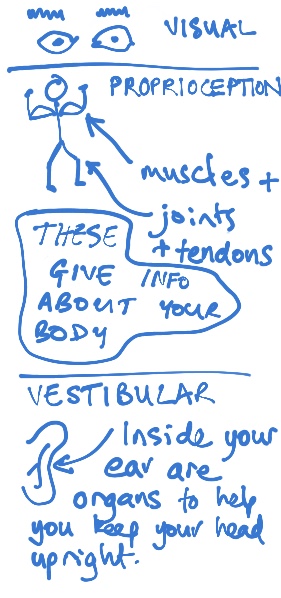
For example, we have these systems built into us which are there for balance.
- Visual system
- Vestibular system
- Proprioceptive system
These give us the ability to respond and adjust ourselves to the "constant falling" effectively.
Someone who has highly developed proprioceptive system is going to be able to respond effectively. The responsiveness of the brain depends on knowing answers to some really important questions.
Where is my head in relationship to my pelvis? Where is the horizon and how am I oriented towards it? What is my contact with the ground like? How are my bones stacked up over my base of support? When I go to take a step, how will my weight shift? What is moving and what is still? How is my breath moving right now?
Someone who has less developed systems of balance doesn't have good answers to these questions. And I'm not talking about logical wordy type answers. I'm talking about embodied answers. Answers that come from a deep well of self-knowledge aquired through paying attention to our senses.
When a tightrope walker senses that they are starting to fall to the left, their brain can sense that and it might make a slight adjustment in the rib-cage. It could be as subtle as breathing a little deeper into one lung to lengthen it more. This would have the effect of bringing the centre of gravity back towards the middle. No hassle, no stress.
If your average person were to attempt the same, even just walking at ground level they would struggle. She might not have the wealth of sensory information available to her and is more likely to make large overcorrections. Jerky movement. Going rigid. Holding the breath. Slipping with the feet.
How to improve your balance by training your brain
You can make improvements to your balance by training these 3 systems.
The most effective way I've discovered for doing this has 2 steps.
Step 1 is to engage in sensory awareness explorations
These not only help you improve balance and coordination. They also release pain, stiffness and fatigue too. ( In future I will be developing audio lessons which help people develop this first step. Let me know if interested!)
In my journey of improving my balance this was the thing I did which made the biggest impact. I have spent hundreds of hours doing the types of explorations I talk about often on this site. They helped to train my brain to be able to respond effectively because I have the right information available.
This type of approach gradually gives you better and better imformation which will carry over into having better balance. It not only trains your brain to have more information, it also trains you to pay more attention while you're doing activities out in the world.
I remember a rave I went to after recently completing one of my training segments in Feldenkrais. I was dancing near the back of the building and it was a concrete floor. There was alcohol spilled all over it so it was extremely slippery. I remember seeing at least 20 people slip over in front of me that night. But my balance had developed to a point where I could feel the slips occurring and just keep moving and adjust on the fly. I didn't even once feel unsafe or have a close call despite dancing like a wild monkey all night. It was just all the practice I'd been doing which was fresh in my awareness.
I want to say 2 other things about whats important in this type of exploration before we move on.
The first is that a well structured exploration will help you to expose your weaknesses and imbalances. This is crucial, because without it your brain doesn't have truly unbiased sensory info. In fact this is often how people discover they have balance issues. They might be doing some kind of uni-lateral exercise and all of a sudden they realies they're super wobbly on one side, but really balance on the other. This is GREAT information to pay attention to.
The other is that it's crucial to do these types of explorations in a really low-risk, low effort, slow easy kind of way. This is how you dial up your ability to sense yourself. Usually it means lying on the floor without any risk of falling. I've spoken a lot about how to improve movement on this site. These principles apply just as much as when you're training your balance.
Step 2 is to apply what you've learned in a fun way
It's all good and well to discover something through somatic exploration, but it needs application to make it stick. The best way to make things stick is by having fun doing them. Luckily there are so many fun activities that we can use to challenge and use our balance.
I have personally used the following things to keep my balance improving...
- Rock climbing and bouldering
- Slack lining
- Rock hopping (along a shoreline) and tree climbing
- Parkour
- General climbing and balancing on structures whenever I see them
- Dance
- Martial arts including Kempo, Japanese Jiu Jitsu and BJJ
- Tai chi and Qi gong.
- Gymnastics and tumbling.
- Play fighting
- Acroyoga
- Yoga
- Surfing
The biggest thing really is to use the environment around you as opportunities for improvement and play. If you see a post, go climb it and balance on it. If you see a line on the ground, see if you can slowly walk along it. If you're putting on your pants - see if you can balance on one leg while inserting your other leg into the pants.
Here's another vid of me playing with my balance at the park in 2017
Take it as a game that you can keep improving at. Find activities that you enjoy that will challenge you.
Remember though, the sensory awareness is the base of it. So your sensory explorations will form the foundation and then everything else is built upon that. If you find yourself getting stuck in an activity without improving, it means you have to develop more sensory awareness first. Keep cycling back and forth and trying diverse things.
This balance improvement is an ongoing relationship that needs to be nurtured.
So basically what I'm saying, is that you're very similar to a lamp that keeps falling over. Except you can improve your ability to stop it before it hits the ground by playing silly games ;-)